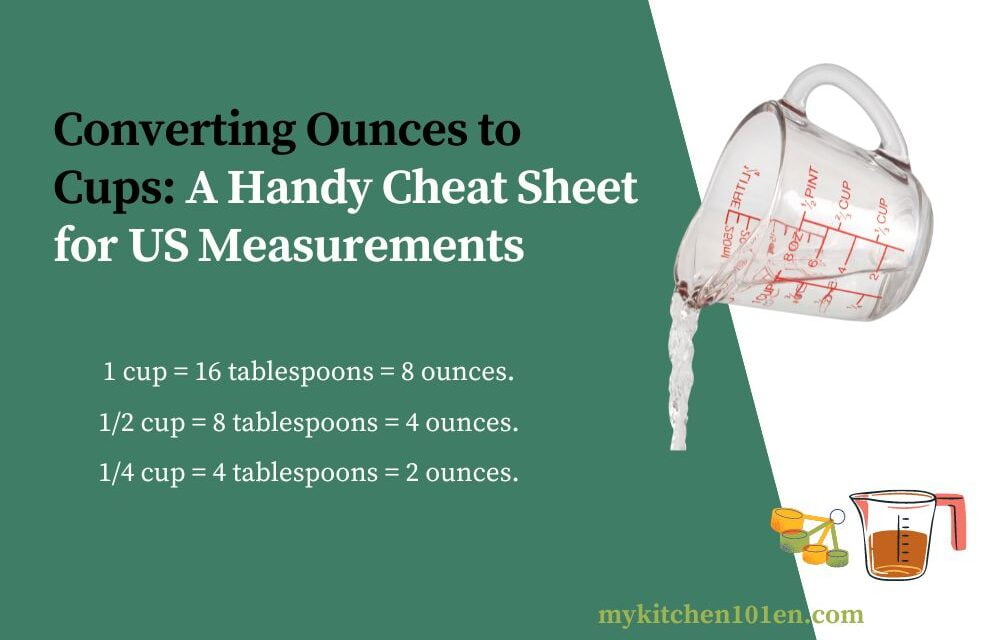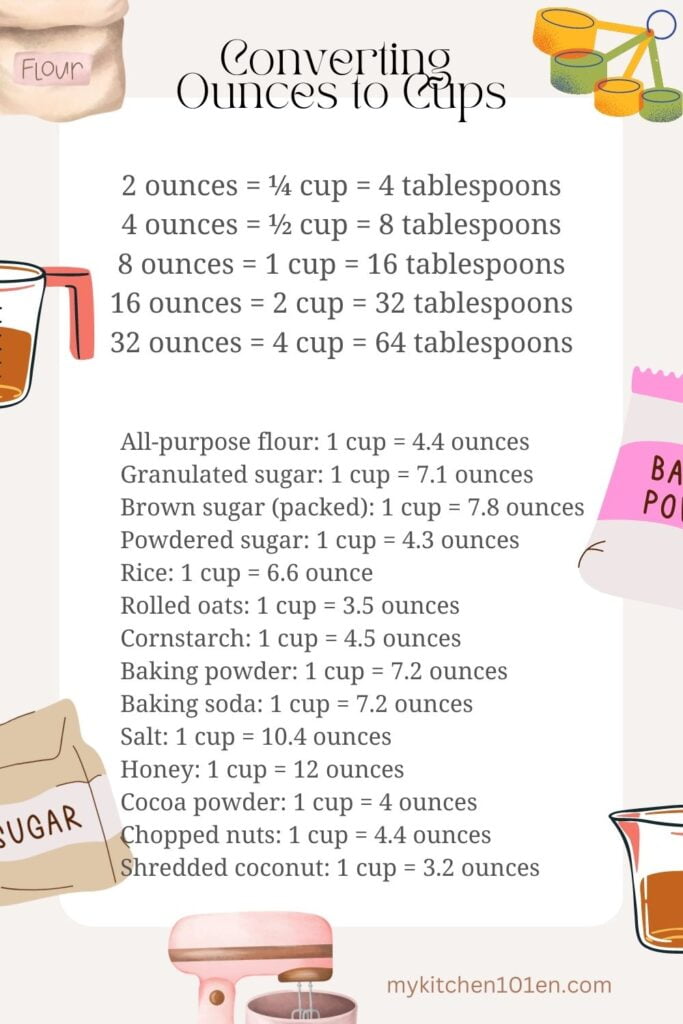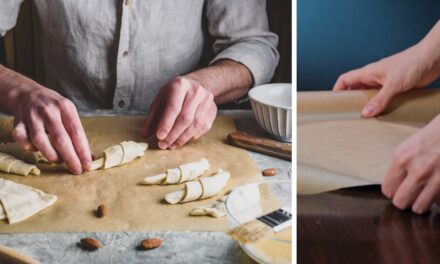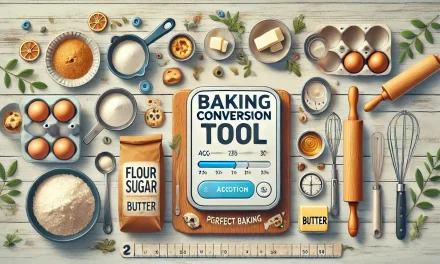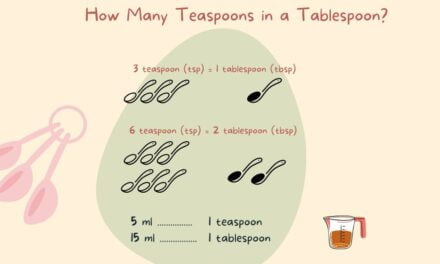Table of Contents
Achieving the perfect taste, texture, and appearance in your cooking and baking relies heavily on accurate measurements. Converting ounces to cups can be confusing, especially when dealing with various ingredients.
In this post, we’ll address one of the most common questions in cooking and baking, ‘how many ounces how many cups?‘, by providing you with a comprehensive conversion guide for various ingredients and measurements, ensuring your baking goods turn out just right every time.
Converting ounces to cups and other US measurements can be confusing. Use our cheat sheet to make cooking and baking easy!
Basics of Measurement Units
Understanding ounces (fluid and dry)
- Definition and usage: Ounces are a unit of weight or volume commonly used in the United States. There are two types of ounces: fluid ounces and dry ounces.
- Difference between fluid ounces and dry ounces: Fluid ounces measure volume and are used for liquids, while dry ounces measure weight and are used for solid ingredients.
Understanding cups
- Definition and usage: Cups are a unit of volume primarily used in the United States for measuring both dry and liquid ingredients.
- US cup size: The US cup is 8 fluid ounces (237 milliliters).
Ounces to Cups Conversion Cheat Sheet
Fluid ounces to cups conversion
- 2 ounces = ¼ cup = 4 tablespoons
- 4 ounces = ½ cup = 8 tablespoons
- 8 ounces = 1 cup = 16 tablespoons
- 16 ounces = 2 cup = 32 tablespoons
- 32 ounces = 4 cup = 64 tablespoons
Here’s a table for converting fluid ounces, cups, and tablespoons in US measurements:
| Fluid Ounces | US Cups | Tablespoons |
|---|---|---|
| 1 | 0.125 | 2 |
| 2 | 0.25 | 4 |
| 3 | 0.375 | 6 |
| 4 | 0.5 | 8 |
| 6 | 0.75 | 12 |
| 8 | 1 | 16 |
| 12 | 1.5 | 24 |
| 16 | 2 | 32 |
Please note that this table is for liquid measurements only.
Tips for measuring fluid ounces accurately: Use a liquid measuring cup with clear markings for fluid ounces, and pour the liquid at eye level to ensure an accurate reading.
Dry ounces to cups conversion
Table for converting dry ounces to cups for common baking and cooking ingredients in US measurements:
| Ingredient | Ounces per Cup | Cups per Ounce |
|---|---|---|
| All-purpose flour | 4.4 | 0.227 |
| Granulated sugar | 7.1 | 0.141 |
| Brown sugar (packed) | 7.8 | 0.128 |
| Powdered sugar | 4.3 | 0.233 |
| Rice | 6.6 | 0.152 |
| Rolled oats | 3.5 | 0.286 |
| Cornstarch | 4.5 | 0.222 |
| Cocoa powder | 4 | 0.25 |
| Baking soda/baking powder | 7.2 | 0.139 |
| Salt | 10.4 | 0.096 |
| Honey | 12 | 0.083 |
| Vegetable oil | 7.7 | 0.13 |
| Almond flour | 3.6 | 0.278 |
| Bread crumbs | 4 | 0.25 |
| Chopped nuts (almonds, walnuts, etc.) | 4.3 | 0.233 |
| Shredded coconut | 3.2 | 0.313 |
| Chocolate chips | 6 | 0.167 |
Please note that these conversions are for specific dry ingredients and may vary slightly depending on factors such as packing, settling, and ingredient variations. Use a digital kitchen scale for precise measurements, and level off dry ingredients using a straight-edged utensil for consistent results.
Related:
- How Many Grams In An Ounce?
- How Many Teaspoons in a Tablespoon? – Explained with Chart
- How Many Liters in a Gallon: Liter to Gallon Conversions Guide
Practical Applications
When to use the kitchen conversion cheat sheet
- When you are adapting recipes from different sources: Use the cheat sheet when working with recipes from various sources, such as cookbooks or online recipes that use different measurement systems.
- Scaling recipes up or down: The cheat sheet can be helpful when increasing or decreasing recipe quantities to accommodate different serving sizes or ingredient availability.
How to use the cheat sheet effectively
- Tips for quick and accurate conversions: Keep the cheat sheet handy in your kitchen, either printed or saved on your mobile device, for easy access when cooking or baking.
- Tools and resources for easier measurements: Invest in a good set of measuring cups and spoons, as well as a digital kitchen scale, to ensure consistent and accurate measurements.
The Bottom Line
Accurate conversions are crucial for successful cooking and baking. This handy cheat sheet will make converting ounces to cups a breeze, allowing you to focus on creating delicious dishes with confidence. Happy cooking!
FAQs on converting ounces to cups
What is the difference between fluid ounces and dry ounces?
Fluid ounces measure volume and are used for liquids, while dry ounces measure weight and are used for solid ingredients.
How many fluid ounces are in a cup?
In US measurements, there are 8 fluid ounces in a cup.
How do I convert dry ounces to cups for various ingredients?
The conversion of dry ounces to cups varies depending on the ingredient. Use the provided cheat sheet in the blog post for common ingredients and their respective conversions.
Are the conversions in the blog post applicable outside the United States?
The conversions in the blog post are specific to US measurements. Cup sizes can vary between countries, such as the UK and Canada, and may require additional conversions.
How can I ensure accurate measurements when converting ounces to cups?
Use a liquid measuring cup with clear markings for fluid ounces and a digital kitchen scale for dry ounces. Pour liquids at eye level and level off dry ingredients using a straight-edged utensil for consistent results.
Can I use the same conversion for all dry ingredients?
No, the conversion of dry ounces to cups varies depending on the ingredient’s density and weight. Refer to the cheat sheet in the blog post for specific conversions for common ingredients.
How do I convert tablespoons to cups and fluid ounces?
There are 16 tablespoons in a US cup and 2 tablespoons in a fluid ounce. You can use the provided table in the blog post for quick conversions between these units.
2 ounces how many cups?
In US measurements, 2 fluid ounces is equal to 0.25 cups (¼ cup). Keep in mind that this conversion is for liquid measurements only. For dry ingredients, the conversion will depend on the specific ingredient being used.

